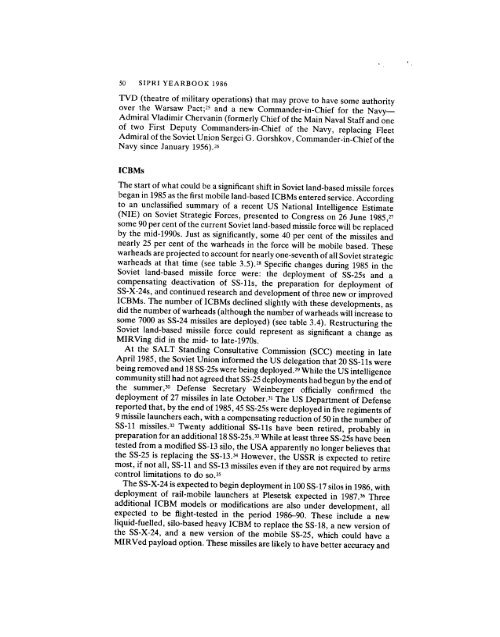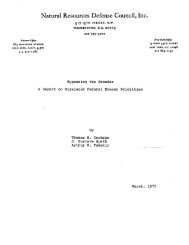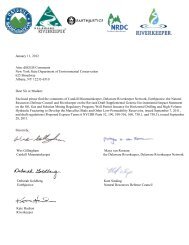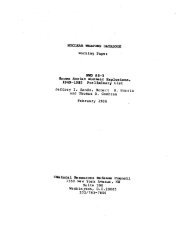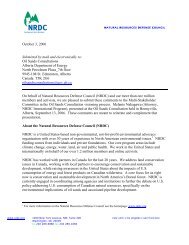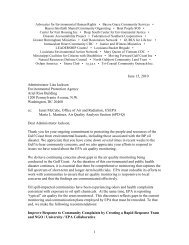3. Nuclear weapons - NRDC Document Bank - Natural Resources ...
3. Nuclear weapons - NRDC Document Bank - Natural Resources ...
3. Nuclear weapons - NRDC Document Bank - Natural Resources ...
You also want an ePaper? Increase the reach of your titles
YUMPU automatically turns print PDFs into web optimized ePapers that Google loves.
50 SIPRI YEARBOOK 1986<br />
TVD (theatre of military operations) that may prove to have some authority<br />
over the Warsaw Pact;25 and a new Commander-in-Chief for the Navy-<br />
Admiral Vladimir Chervanin (formerly Chief of the Main Naval Staff and one<br />
of two First Deputy Commanders-in-Chief of the Navy, replacing Fleet<br />
Admiral of the Soviet Union Sergei G. Gorshkov, Commander-in-Chief of the<br />
Navy since January 1956).26<br />
The start of what could be a significant shift in Soviet land-based missile forces<br />
began in 1985 as the first mobile land-based ICBMs entered service. According<br />
to an unclassified summary of a recent US National Intelligence Estimate<br />
(NIE) on Soviet Strategic Forces, presented to Congress on 26 June 1985,27<br />
some 90 per cent of the current Soviet land-based missile force will be replaced<br />
by the mid-1990s. Just as significantly, some 40 per cent of the missiles and<br />
nearly 25 per cent of the warheads in the force will be mobile based. These<br />
warheads are projected to account for nearly one-seventh of all Soviet strategic<br />
warheads at that time (see table <strong>3.</strong>5).28 Specific changes during 1985 in the<br />
Soviet land-based missile force were: the deployment of SS-25s and a<br />
compensating deactivation of SS-l1s, the preparation for deployment of<br />
SS-X-24s, and continued research and development of three new or improved<br />
ICBMs. The number of ICBMs declined slightly with these developments, as<br />
did the number of warheads (although the number of warheads will increase to<br />
some 7000 as SS-24 missiles are deployed) (see table <strong>3.</strong>4). Restructuring the<br />
Soviet land-based missile force could represent as significant a change as<br />
MIRVing did in the mid- to late-1970s.<br />
At the SALT Standing Consultative Commission (SCC) meeting in late<br />
April 1985, the Soviet Union informed the US delegation that 20 SS-l1s were<br />
being removed and 18 SS-25s were being deployed. 29 While the US intelligence<br />
community still had not agreed that SS-25 deployments had begun by the end of<br />
the summer,30 Defense Secretary Weinberger officially confirmed the<br />
deployment of 27 missiles in late October.31 The US Department of Defense<br />
reported that, by the end of 1985,45 SS-25s were deployed in five regiments of<br />
9 missile launchers each, with a compensating reduction of 50 in the number of<br />
SS-l1 missiles.J2 Twenty additional SS-l1s have been retired, probably in<br />
preparation for an additional 18 SS-25s.33While at least three SS-25s have been<br />
tested from a modified SS-13 silo, the USA apparently no longer believes that<br />
the SS-25 is replacing the SS-1<strong>3.</strong>34However, the USSR is expected to retire<br />
most, if not all, SS-l1 and SS-13 missiles even if they are not required by arms<br />
control limitations to do SO.35<br />
The SS-X-24 is expected to begin deployment in 100 SS-17 silos in 1986, with<br />
deployment of rail-mobile launchers at Plesetsk expected in 1987.36Three<br />
additional ICBM models or modifications are also under development, all<br />
expected to be flight-tested in the period 1986-90. These include a new<br />
liquid-fuelled, silo-based heavy ICBM to replace the SS-18, a new version of<br />
the SS-X-24, and a new version of the mobile SS-25, which could have a<br />
MIRVed payload option. These missiles are likely to have better accuracy and


